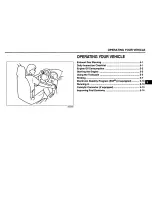
119
When the vehicle is parked
Condensation forms while the automatic cli-
mate control is in operation, and then exits
under the vehicle. Traces of condensed water
under the vehicle are therefore normal.
Cargo loading
To avoid loading the tires beyond their
approved carrying capacity, never over-
load the vehicle. Overloading can lead to over-
heating and increases the rate at which damage
develops inside the tires. This can ultimately
result in a sudden blowout.
<
Make sure that no liquids are spilled or
leak from their containers in the cargo
area, as this could result in damage to the vehi-
cle.
<
Determining loading limit
1.
Locate the following statement on your
vehicle's placard
*
:
The combined weight of occupants
and cargo should never exceed
XXX kg or YYY lbs. Otherwise, overloading
can result in damage to the vehicle and
unstable driving conditions.
<
2.
Determine the combined weight of the
driver and passengers that will be riding in
your vehicle.
3.
Subtract the combined weight of the driver
and passengers from XXX kilograms or YYY
pounds.
4.
The resulting figure equals the available
amount of cargo and luggage load capacity.
For example, if the YYY amount equals
1,400 lbs. and there will be five 150-lb. pas-
sengers in your vehicle, the amount of avail-
able cargo and luggage load capacity is
650 lbs:
1,400 lbs. minus 750 lbs. = 650 lbs.
5.
Determine the combined weight of luggage
and cargo being loaded on the vehicle. That
weight may not safely exceed the available
cargo and luggage load capacity calculated
in step 4.
6.
If your vehicle will be towing a trailer, part of
the load from your trailer will be transferred
to your vehicle. Consult the manual for
transporting a trailer to determine how this
may reduce the available cargo and luggage
load capacity of your vehicle.
Load
The permissible load is the total of the weight of
occupants and cargo/luggage. The greater the
weight of the occupants, the less cargo/lug-
gage can be transported.
Stowing cargo
>
Position heavy objects as low and as far for-
ward as possible, ideally directly behind the
respective seat backrests.
>
Cover sharp edges and corners.
>
For very heavy cargo when the rear seat is
not occupied, secure each safety belt in the
opposite buckle.
Online Edition for Part no. 01 41 2 603 066 - © 08/09 BMW AG
Online Edition for Part no. 01 41 2 603 066 - © 08/09 BMW AG
Summary of Contents for 2010 323i
Page 2: ...Online Edition for Part no 01 41 2 603 066 08 09 BMW AG ...
Page 10: ...Online Edition for Part no 01 41 2 603 066 08 09 BMW AG ...
Page 26: ...Online Edition for Part no 01 41 2 603 066 08 09 BMW AG ...
Page 116: ...Online Edition for Part no 01 41 2 603 066 08 09 BMW AG ...
Page 124: ...Online Edition for Part no 01 41 2 603 066 08 09 BMW AG ...
Page 144: ...Online Edition for Part no 01 41 2 603 066 08 09 BMW AG ...
Page 174: ...Online Edition for Part no 01 41 2 603 066 08 09 BMW AG ...
Page 196: ...Online Edition for Part no 01 41 2 603 066 08 09 BMW AG ...
Page 244: ...Online Edition for Part no 01 41 2 603 066 08 09 BMW AG ...
















































